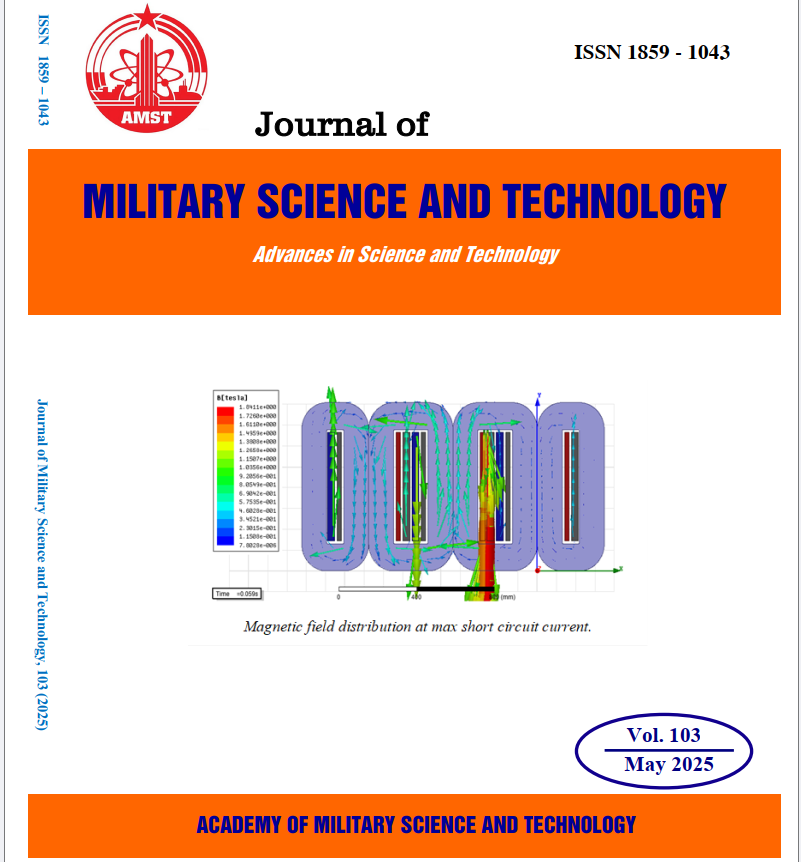Phương pháp xác định tỉ lệ truyền bức xạ nhiệt qua tấm vật liệu ngụy trang ảnh nhiệt sử dụng máy đo phổ bức xạ từ xa SR-5000N
205 lượt xemDOI:
https://doi.org/10.54939/1859-1043.j.mst.103.2025.74-81Từ khóa:
Ngụy trang ảnh nhiệt, Dấu hiệu nhiệt, Hệ số phát xạ, Hệ số truyền nhiệt, Thiết bị đo phổ bức xạ SR-5000NTóm tắt
Nghiên cứu ngụy trang trong nước gần đây đòi hỏi các phương pháp, kỹ thuật đánh giá tiêu chuẩn hóa để kiểm tra vật liệu ngụy trang (như vải, lưới ngụy trang) một cách khoa học và đáng tin cậy. Đây là thách thức lớn do tính bảo mật cao của lĩnh vực và hạn chế về thiết bị thí nghiệm. Dựa trên một số tiêu chuẩn đã được các quốc gia tiên tiến công bố, bài báo đã đề xuất phương pháp xác định tỉ lệ truyền bức xạ nhiệt qua tấm vật liệu ngụy trang trong phòng thí nghiệm bằng thiết bị SR-5000N được trang bị. Phương pháp đề xuất có nhiều ưu điểm là thực hiện nhanh chóng, chính xác, tin cậy với dải phổ rộng bao gồm hai vùng phổ chính của ngụy trang ảnh nhiệt là MWIR và LWIR. Kết quả đánh giá độc lập tại thực địa đã chứng minh tính phù hợp của phương pháp đề xuất, giúp tiết kiệm thời gian và nguồn lực trong hoạt động đánh giá hiệu quả ngụy trang ảnh nhiệt.
Tài liệu tham khảo
[1]. N.T. Cầm, “Nguỵ trang nghi trang trong phòng chống trinh sát quang điện tử,” Giáo trình đào tạo NCS của Viện KH-CN quân sự/BTTM, NXB Quân đội Nhân dân (2023) (in Vietnamese).
[2]. N.N. Son et al., “Advances in manufacturing multi-layer materials for thermal camouflage applications,” Journal of Military Science and Technology, 97, 3-15, (2024).
[3]. N.N. Son et al., “Developing computational and experimental models of heat transfer through multi-layered textile structures”, Comm. Phys., vol. 34, no. 4, (2024). DOI: https://doi.org/10.15625/0868-3166/20945
[4]. A. Roglski, “Infrared detectors, An overview,” Inf. Phys. Technol. 43, tr. 187-210, (2002). DOI: https://doi.org/10.1016/S1350-4495(02)00140-8
[5]. D. Peric et al, “Thermal imager range: Predictions, expectations and reality,” Sensor, 19(15), 3313, (2019). DOI: https://doi.org/10.3390/s19153313
[6]. J. Berela, M. Kastek, “Measurement and analysis of the parameters of modern long-range thermal imaging cameras”, Sensor (17), 5700, (2021). DOI: https://doi.org/10.3390/s21175700
[7]. F.B. Olsen, “Methods for evaluating thermal camouflage,” A FFI Report No. RTO-MPSCI-145, (2005).
[8]. C. Plesa et al, “The use of infrared radiation for thermal signatures determination of ground targets,” Rom. J. Phys. 51, pp.63–72, (2006).
[9]. J.G. Hixon et al, “Target detection cycle criteria when using the target task metric,” SPIE 5612, pp. 275–276, (2004). DOI: https://doi.org/10.1117/12.577830
[10]. G.C. Holst, “Common sense approach to thermal imaging,” JCD and SPIE Pub., 2000, pp. 265–290. DOI: https://doi.org/10.1117/3.2588945
[11]. O. Dev et al, “Multi-layered textile structure for thermal signature suppression of ground-based targets,” Inf. Phys. Technol. 105, 103175, (2020). DOI: https://doi.org/10.1016/j.infrared.2019.103175
[12]. Hexels, “Thermal Camouflage sheet,” US Patent 7244684 B2, (2007).
[13]. Hellwig et al, “Thermal Camouflage tarpaulin,” US Patent 7148161 B2, (2006).
[14]. Cox et al, “Infrared Camouflage covering,” US Patent 6127007, (2000).
[15]. G.D. Culler et al, “Infrared reflective coverings,” US Patent 5750242, (1998).
[16]. V. Rubeziene et al, “Reduction of thermal signature using fabrics with conductive additives,” Mater. Sci. (Medziagotyra) 19, pp.409–414, (2013). DOI: https://doi.org/10.5755/j01.ms.19.4.1730
[17]. C. Oahman, “Emittance Measurement using AGEMA E-Box,” Technical Report, AGEMA, (1999).
[18]. Z.S. Abdel-Rehim et al, “Textile fabrics as thermal insulators,” AUTEX Res. J.6, pp.148-161, (2006). DOI: https://doi.org/10.1515/aut-2006-060305
[19]. M. Matusiak, “Investigation of the thermal insulation properties of multilayer textiles,” J. Fibres Text. East. Eur. 14, pp.98–102, (2006).
[20]. N.N. Son et al, “A high-accuracy measurement method of surface emissivity using a spectroradiometer SR-5000N,” Proc. of 8th CASEAN, 28-30 August, Vinh, pp.674-681, (2023).
[21]. M. Honner and P. Honnerová, “Survey of emissivity measurement by radiometric methods,” Appl. Opt. 54, 669-683, (2015). DOI: https://doi.org/10.1364/AO.54.000669
[22]. O. Nagahisa et al, “Infrared emissivity measurement based on polarized reflection characteristics of non-transmissive insulators,” Mechanical Engineering Journal, 24-00115, (2024). DOI: https://doi.org/10.1299/mej.24-00115
[23]. G. Gillberg, A. Grop and M. Nysten, Technical specification MLCN, FMV, pp. 8-9, (2013).
[24]. N. Li et al, “Research status and development trend of image camouflage effect evaluation,” Multimedia Tools and Applications, 81, pp. 29939-29953, (2022). DOI: https://doi.org/10.1007/s11042-022-12287-3
[25]. R. Karli et al, “A multispectral Camouflage net evaluation capability,” IEEE Access, 12, 143378-143391, (2024). DOI: https://doi.org/10.1109/ACCESS.2024.3471182
[26]. N.N. Son et al, “Research on evaluating camouflage effectiveness based on the data envelopment analysis (DEA) model,” Proc. of ICPA-13, 14-17 October, Ha Noi (2024).







